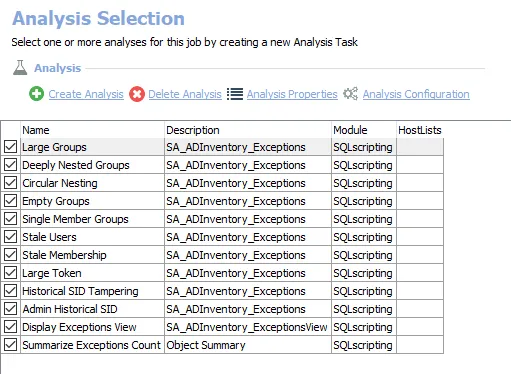3-AD_Exceptions Job
The 3-AD_Exceptions Job identifies toxic conditions that exist within Active Directory which may leave your environment at risk or add unnecessary administrative overhead. It is dependent on running the 1-AD_Scan Job, also located in the .Active Directory Inventory Job Group.
Parameter Configuration
The Configuration section on a Job's overview page allows you to easily modify any customizable parameters used by analysis tasks in the job. See the Parameter Configuration topic for instructions on how to edit parameters on a job overview page.
The 3-AD_Exceptions Job has the following configurable parameters:
- Threshold of group members
- Threshold of nesting
- Threshold necessary to identify a stale group (0-100%)
- Whether to include disabled users that are stale
- Whether to include expired users that are stale
- Threshold for token size
- List of administrative groups
See the Customize Analysis Parameters for the 3-AD_Exceptions Job topic for additional information.
Analysis Tasks for the 3-AD_Exceptions Job
View the analysis tasks by navigating to the .Active Directory Inventory > 3-AD_Exceptions > Configure node and select Analysis. Analysis tasks with configuration parameters that define the security concerns within them can be modified.
CAUTION: Do not modify or deselect the selected analysis tasks. The analysis tasks are preconfigured for this job.

The following analysis tasks are selected by default:
-
Large Groups
- Identifies groups that exceeded the defined threshold for effective group membership
- Populates processing tables in the database for use by downstream analysis and report generation
- Definition of a large group can be customized
-
Deeply Nested Groups
- Identifies groups that exceeded the defined threshold of deep levels of membership nesting
- Populates processing tables in the database for use by downstream analysis and report generation
- Definition of a deeply nested group can be customized
-
Circular Nesting
- Identifies groups with circular references in their effective membership
- Populates processing tables in the database for use by downstream analysis and report generation
-
Empty Groups
- Identifies groups with no membership
- Populates processing tables in the database for use by downstream analysis and report generation
-
Single Member Groups
- Identifies groups with a single direct member
- Populates processing tables in the database for use by downstream analysis and report generation
-
Stale Users
- Identifies user accounts that are expired, are disabled, or have exceeded the defined threshold of inactivity
- Populates processing tables in the database for use by downstream analysis and report generation
- Definition of a stale user can be customized
-
Stale Membership
- Identifies groups with a high percentage of effective members that are stale users
- Populates processing tables in the database for use by downstream analysis and report generation
- Definition of stale membership can be customized
-
Large Token
- Identifies users that exceeded the defined threshold for effective membership in authorization groups
- Populates processing tables in the database for use by downstream analysis and report generation
- Definition of a large token can be customized
-
Historical SID Tampering
- Identifies users that have a historical SID from their current domain
- Populates processing tables in the database for use by downstream analysis and report generation
-
Admin Historical SID
- Identifies users that have a historical SID from an administrator account
- Populates processing tables in the database for use by downstream analysis and report generation
- Definition of an administrator group can be customized
-
Display Exceptions View – Creates the SA_ADInventory_ExceptionsView accessible under the job’s Results node
-
Summarize Exceptions Count – Generates data used in the Exceptions report
In addition to the tables and views created by the analysis tasks, the 3-AD_Exceptions Job produces the following pre-configured report:
| Report | Description | Default Tags | Report Elements |
|---|---|---|---|
| Exceptions Summary (A.K.A. AD Exceptions) | This report summarizes common issues with user accounts and group membership | None | This report is comprised of three elements: - Pie Chart – Displays exceptions by class - Table – Provides exceptions by count - Table – Provides details on exceptions |
Customize Analysis Parameters for the 3-AD_Exceptions Job
Exception definitions that can be customized have the following default values for the customizable parameters:
| Analysis Task | Customizable Parameter Name | Default Value | Value Indicates |
|---|---|---|---|
| Large Groups | @LARGE_THRESHOLD | 10 | A group object with 10 members or more |
| Deeply Nested Groups | @NESTING_THRESHOLD | 1 | A group object nested 1 level or deeper within another group object |
| Stale Users | @STALE_THRESHOLD | 60 | A user object that has been inactive for 60 days or more |
| @INCLUDE_DISABLED | True | A user object that has been disabled | |
| @INCLUDE_EXPIRED | True | A user object that has expired | |
| Stale Membership | @STALE_THRESHOLD | 10 | A group with 10% of its effective members are stale users |
| Large Token | @TOKEN_THRESHOLD | 10 | A user object with effective membership in more than 10 group objects |
| Admin Historical SID | #ADMIN_GROUPS | - Domain Admins - Enterprise Admins - Schema Admins | List of administrative groups |
See the Configure the Customizable Parameters in an Analysis Task topic for instructions to modify the parameters. See the AD Exception Types Translated topic for an explanation of Exception Types.